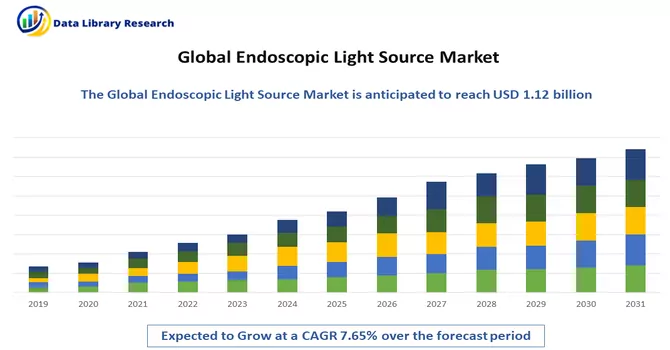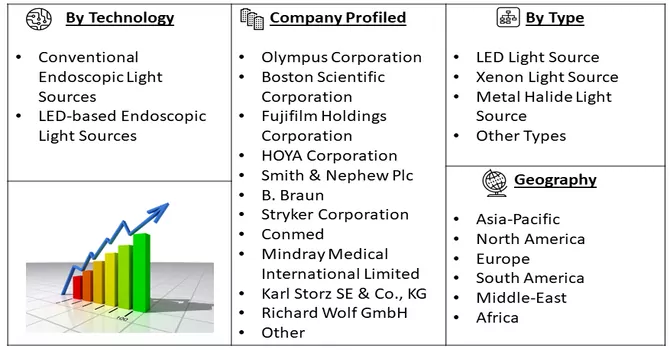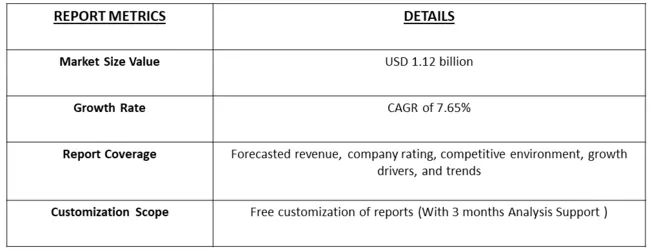The global endoscope light source market size is expected to be USD 1.12 billion in 2023 and is projected to register a CAGR of 7.65% over the forecast period, 2024-2031.

Get Complete Analysis Of The Report - Download Free Sample PDF
The endoscopic light source market is witnessing substantial growth globally, driven by advancements in endoscopic technology, rising demand for minimally invasive procedures, and increasing prevalence of chronic diseases. Endoscopic procedures offer several advantages over traditional surgical methods, including reduced patient discomfort, shorter recovery times, and lower risk of complications. As healthcare providers and patients increasingly recognize these benefits, there is a growing preference for endoscopic procedures across various medical specialties.
Furthermore, technological innovations such as LED and xenon light sources are enhancing the quality of endoscopic imaging, enabling clearer visualization of anatomical structures and pathological conditions. Additionally, the expanding geriatric population, coupled with the rising incidence of gastrointestinal and urological disorders, is fueling the demand for endoscopic examinations and procedures. However, challenges such as high costs associated with endoscopic equipment and the need for skilled healthcare professionals may hinder market growth to some extent. Nonetheless, ongoing research and development efforts aimed at improving endoscopic devices and expanding their applications are expected to drive significant opportunities for market expansion in the coming years. The growth of the endoscopic light source market is primarily driven by technological advancements in endoscopic equipment and increasing adoption of minimally invasive procedures across various medical specialties. Technological innovations, such as the development of LED and xenon light sources, have significantly improved the quality of endoscopic imaging, allowing for clearer visualization of anatomical structures and pathological conditions. Moreover, the rising prevalence of chronic diseases, coupled with the expanding geriatric population, has led to an increase in the demand for endoscopic examinations and procedures. Patients and healthcare providers increasingly prefer minimally invasive techniques due to their associated benefits, such as reduced patient discomfort, shorter recovery times, and lower risk of complications compared to traditional surgical methods. Additionally, the growing awareness among healthcare professionals about the advantages of endoscopic procedures and the continuous introduction of advanced endoscopic devices further contribute to market growth. As a result, the endoscopic light source market is expected to experience significant expansion in the coming years.
Market Segmentation: The endoscopic light source market is Segmented by Technology (Conventional Endoscopic Light Sources and LED-based Endoscopic Light Sources), Type (LED Light Source, Xenon Light Source, Metal Halide Light Source and Other Types), and Geography (North America, Europe, Asia-Pacific, Middle East and Africa, and South America). The market values are provided in terms of (USD million) for the above segments.

For Detailed Market Segmentation - Download Free Sample PDF
In the endoscopic light source market, several notable trends are shaping the industry landscape. One prominent trend is the increasing adoption of energy-efficient and eco-friendly light sources, such as LED (Light Emitting Diode) technology. LED light sources offer advantages like lower energy consumption, longer lifespan, and reduced heat emission compared to traditional xenon light sources. Additionally, there is a growing demand for compact and portable endoscopic light sources, driven by the need for flexibility and ease of use in various clinical settings, including ambulatory surgical centers and outpatient clinics. Another notable trend is the integration of advanced features into endoscopic light sources, such as adjustable light intensity, color temperature control, and compatibility with different endoscopic imaging modalities. These features enhance the quality of endoscopic visualization and improve the overall efficiency of procedures. Furthermore, the emergence of wireless and battery-powered endoscopic light sources is gaining traction, offering greater mobility and eliminating the need for cumbersome cables during endoscopic examinations. Overall, these trends reflect the continuous innovation and technological advancements in the endoscopic light source market to meet the evolving needs of healthcare professionals and improve patient outcomes.
Market Drivers:
Technological Advancements
Ongoing technological advancements in endoscopic light source technology drive market growth. Innovations such as LED (Light Emitting Diode) light sources offer benefits like energy efficiency, longer lifespan, and improved color rendering compared to traditional light sources. Additionally, manufacturers are continuously introducing advanced features such as adjustable light intensity, color temperature control, and compatibility with different endoscopic imaging modalities, enhancing the overall performance and versatility of endoscopic light sources.
Increasing Endoscopic Procedures
The rising prevalence of gastrointestinal diseases, cancers, and other medical conditions necessitating endoscopic examinations is a key driver for the endoscopic light source market. The growing aging population, coupled with lifestyle changes and dietary habits, contributes to the increasing demand for endoscopic procedures for diagnosis, treatment, and surveillance of various gastrointestinal and respiratory disorders. Moreover, the expanding applications of endoscopy in minimally invasive surgeries, such as laparoscopy and arthroscopy, further propel the demand for high-quality endoscopic light sources to ensure optimal visualization during procedures.
Market Restraints:
One significant market restraint for the endoscopic light source market is the high cost associated with advanced endoscopic light source systems. The initial investment required for purchasing sophisticated light source equipment, including LED light sources with advanced features and compatibility with various endoscopic devices, can be substantial for healthcare facilities, particularly in developing regions with limited financial resources. Additionally, the need for periodic maintenance, calibration, and replacement of consumable components further adds to the overall cost of ownership. As a result, budget constraints among healthcare providers may limit their ability to invest in state-of-the-art endoscopic light source systems, hindering market growth to some extent. Moreover, stringent regulatory requirements and compliance standards for medical devices may pose challenges for manufacturers in terms of product development, certification, and market entry, thereby restraining market expansion.
The COVID-19 pandemic has had a notable impact on the endoscopic light source market. While endoscopic procedures are essential for diagnosing and treating various medical conditions, including gastrointestinal disorders and cancers, the pandemic has led to disruptions in healthcare services worldwide. Many elective procedures, including non-urgent endoscopic examinations, were postponed or canceled to prioritize resources for managing COVID-19 cases and to minimize the risk of virus transmission. This reduction in procedural volumes has resulted in a decline in the demand for endoscopic equipment, including light sources, during the initial phases of the pandemic. Additionally, stringent infection control measures and safety protocols implemented in healthcare facilities have led to changes in procedural workflows, requiring modifications to endoscopic equipment usage and maintenance practices. However, as healthcare systems adapt to the challenges posed by the pandemic and resume elective procedures, the demand for endoscopic light sources is expected to gradually recover, supported by the resumption of routine endoscopic examinations and surgeries. Furthermore, the growing adoption of minimally invasive procedures, including endoscopic techniques, for the diagnosis and treatment of gastrointestinal disorders is anticipated to drive long-term market growth, albeit at a moderated pace due to the lingering effects of the pandemic on healthcare systems and patient volumes.
Segmental Analysis:
Conventional Endoscopic Light Sources Segment is Expected to Witness Significant Growth Over the Forecast Period
Conventional endoscopic light sources are a crucial component of endoscopy systems, providing the necessary illumination for clear visualization during procedures. These light sources have been a standard in the field for many years, offering reliable and consistent lighting for various endoscopic procedures. The endoscopic light source market includes a wide range of conventional light sources, including xenon, halogen, and metal halide lamps. These light sources are typically used in conjunction with fiber optic cables to deliver light to the endoscope's tip, ensuring optimal illumination of the area being examined. One of the key advantages of conventional endoscopic light sources is their proven track record of performance and reliability. These light sources have been extensively used in clinical settings and have undergone significant refinements over the years to enhance their efficiency and durability. However, conventional endoscopic light sources also have some limitations, such as heat generation and the need for regular maintenance and bulb replacement. These factors have led to the development of newer technologies, such as LED-based light sources, which offer advantages such as lower heat generation, longer lifespan, and more consistent light output. Despite these challenges, conventional endoscopic light sources continue to be widely used in many healthcare settings due to their cost-effectiveness and familiarity among healthcare providers. As the endoscopic light source market continues to evolve, there is a growing focus on developing innovative solutions that address the limitations of conventional light sources while maintaining their core benefits of reliability and performances.
Metal Halide Light Source Segment is Expected to Witness Significant Growth Over the Forecast Period
Metal halide light sources are a type of high-intensity discharge lamp used in various applications, including endoscopy. In the medical field, metal halide light sources are commonly used in endoscopic systems to provide bright, white light for clear visualization during procedures. One of the key advantages of metal halide light sources is their high color rendering index (CRI), which ensures that tissues and organs appear natural and vibrant under the light, aiding in the accurate diagnosis and treatment of medical conditions. Metal halide lamps also have a long lifespan compared to traditional incandescent bulbs, reducing the need for frequent replacements and maintenance. Metal halide light sources are known for their ability to produce intense, focused light, making them ideal for use in endoscopic procedures where precise illumination is required. The light produced by metal halide lamps is also cooler compared to other types of light sources, reducing the risk of tissue damage or discomfort to the patient. However, metal halide light sources also have some limitations. They can be expensive to purchase and operate compared to other types of light sources, such as LED lights. Additionally, metal halide lamps require a warm-up period to reach full brightness, which can be inconvenient in time-sensitive procedures. Despite these limitations, metal halide light sources continue to be widely used in endoscopy and other medical applications due to their superior light quality and performance. As technology continues to advance, there is ongoing research and development aimed at improving the efficiency and cost-effectiveness of metal halide lamps, ensuring their continued relevance in the medical field.
North America Region is Expected to Witness Significant Growth Over the Forecast Period
North America is a key region in the global endoscopic light source market, driven by factors such as the presence of advanced healthcare infrastructure, a high prevalence of gastrointestinal disorders, and increasing adoption of minimally invasive procedures. The region is characterized by a strong demand for innovative medical technologies, including endoscopic light sources, to improve patient outcomes and reduce healthcare costs. The endoscopic light source market in North America is dominated by advanced technologies such as LED-based light sources, which offer advantages such as longer lifespan, lower heat generation, and more consistent light output compared to traditional light sources like xenon and halogen lamps. LED-based light sources are increasingly being adopted in endoscopic procedures due to their superior performance and cost-effectiveness. Another factor driving the growth of the endoscopic light source market in North America is the increasing prevalence of gastrointestinal diseases such as colorectal cancer, inflammatory bowel disease, and gastroesophageal reflux disease. These conditions often require endoscopic procedures for diagnosis and treatment, driving the demand for advanced endoscopic equipment, including light sources. Furthermore, the growing trend towards outpatient and ambulatory surgical centers in North America is also contributing to the growth of the endoscopic light source market. These facilities often prefer portable and cost-effective endoscopic equipment, including light sources, to perform a wide range of procedures in a more convenient and efficient manner. Thus, the endoscopic light source market in North America is poised for significant growth in the coming years, driven by factors such as technological advancements, increasing prevalence of gastrointestinal disorders, and the shift towards outpatient and ambulatory surgical centers. As healthcare providers in the region continue to embrace minimally invasive techniques, the demand for advanced endoscopic equipment, including light sources, is expected to rise, further fueling market growth.

Get Complete Analysis Of The Report - Download Free Sample PDF
The analyzed market exhibits a high degree of fragmentation, primarily attributable to the presence of numerous players operating on both a global and regional scale. The competitive landscape is characterized by a diverse array of companies, each contributing to the overall market dynamics. This fragmentation arises from the existence of specialized solution providers, established industry players, and emerging entrants, all vying for market share. The diversity in market participants is underscored by the adoption of various strategies aimed at expanding the company presence. On a global scale, companies within the studied market are strategically positioning themselves through aggressive expansion initiatives. This often involves entering new geographical regions, targeting untapped markets, and establishing a robust global footprint. The pursuit of global expansion is driven by the recognition of diverse market opportunities and the desire to capitalize on emerging trends and demands across different regions. Simultaneously, at the regional level, companies are tailoring their approaches to align with local market dynamics. Regional players are leveraging their understanding of specific market nuances, regulatory environments, and consumer preferences to gain a competitive edge. This regional focus allows companies to cater to the unique needs of local clientele, fostering stronger market penetration. To navigate the complexities of the fragmented market, companies are implementing a range of strategies. These strategies include investments in research and development to stay at the forefront of technological advancements, mergers and acquisitions to consolidate market share, strategic partnerships for synergies, and innovation to differentiate products and services. The adoption of such multifaceted strategies reflects the competitive nature of the market, with participants continually seeking avenues for growth and sustainability. In essence, the high fragmentation in the studied market not only signifies the diversity of players but also underscores the dynamism and competitiveness that drive ongoing strategic maneuvers. As companies explore various avenues for expansion, the market continues to evolve, presenting both challenges and opportunities for industry stakeholders.
Some major companies operating in the global light sources for endoscopy market include:
Recent Development:
1) In August 2023, Olympus Corporation, a global medical technology company committed to improving people's lives, announced the market launch of its next-generation EVIS X1™ endoscopy system. The system was showcased and demonstrated from October 22-24 during the American College of Gastroenterology (ACG) annual meeting in Vancouver, Canada.
2) In May 2023, Olympus Corporation, a global technology leader in innovative medical and surgical solutions, announced the FDA clearance of the new EVIS X1 endoscopy system, along with two compatible gastrointestinal endoscopes. The GIF-1100 gastrointestinal videoscope was indicated for use in the upper digestive tract, including the esophagus, stomach, and duodenum, while the CF-HQ1100DL/I colonovideoscope was indicated for use in the lower digestive tract, including the anus, rectum, sigmoid colon, colon, and ileocecal valve.
Q1. What was the Endoscopic Light Source Market size in 2023?
As per Data Library Research the Endoscope Light Source market size is expected to be USD 1.12 billion in 2023.
Q2. What is the Growth Rate of the Endoscopic Light Source Market ?
Endoscopic Light Source Market is projected to register a CAGR of 7.65% over the forecast period.
Q3. What segments are covered in the Endoscopic Light Source Market Report?
By Technology, By Type and Geography these segments are covered in the Endoscopic Light Source Market Report.
Q4. What are the Growth Drivers of the Endoscopic Light Source Market?
Technological Advancements and Increasing Endoscopic Procedures are the Growth Drivers of the Endoscopic Light Source Market.
Data Library Research are conducted by industry experts who offer insight on industry structure, market segmentations technology assessment and competitive landscape (CL), and penetration, as well as on emerging trends. Their analysis is based on primary interviews (~ 80%) and secondary research (~ 20%) as well as years of professional expertise in their respective industries. Adding to this, by analysing historical trends and current market positions, our analysts predict where the market will be headed for the next five years. Furthermore, the varying trends of segment & categories geographically presented are also studied and the estimated based on the primary & secondary research.
In this particular report from the supply side Data Library Research has conducted primary surveys (interviews) with the key level executives (VP, CEO’s, Marketing Director, Business Development Manager and SOFT) of the companies that active & prominent as well as the midsized organization
FIGURE 1: DLR RESEARH PROCESS

Extensive primary research was conducted to gain a deeper insight of the market and industry performance. The analysis is based on both primary and secondary research as well as years of professional expertise in the respective industries.
In addition to analysing current and historical trends, our analysts predict where the market is headed over the next five years.
It varies by segment for these categories geographically presented in the list of market tables. Speaking about this particular report we have conducted primary surveys (interviews) with the key level executives (VP, CEO’s, Marketing Director, Business Development Manager and many more) of the major players active in the market.
Secondary ResearchSecondary research was mainly used to collect and identify information useful for the extensive, technical, market-oriented, and Friend’s study of the Global Extra Neutral Alcohol. It was also used to obtain key information about major players, market classification and segmentation according to the industry trends, geographical markets, and developments related to the market and technology perspectives. For this study, analysts have gathered information from various credible sources, such as annual reports, sec filings, journals, white papers, SOFT presentations, and company web sites.
Market Size EstimationBoth, top-down and bottom-up approaches were used to estimate and validate the size of the Global market and to estimate the size of various other dependent submarkets in the overall Extra Neutral Alcohol. The key players in the market were identified through secondary research and their market contributions in the respective geographies were determined through primary and secondary research.
Forecast Model
